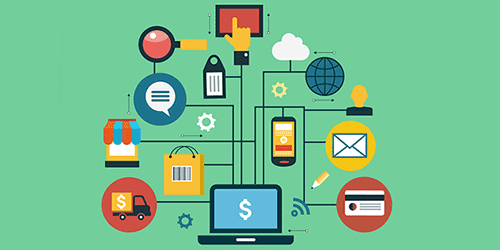There are merchants moving their retail stores to an e-commerce store. There are many advantages and disadvantages for doing this.
The e-commerce definition is buying and selling electronically over the internet. This could be just about anything, products, services, subscriptions, etc. By having a store, you are giving people all over the internet access to your products at any time of day.
North American online ad spending will grow nearly 14% annually from 2011-2016, eMarketer predicts. By 2016 it will account for 31.4% of all advertising dollars. –eMarketer
B2C vs B2B

There are two types of e-commerce stores that you can showcase. There is business to consumer (B2C) and business to business (B2B).
Your platform and hierarchy of the store will be the same for both scenarios. What is going to change is how the products are going to be displayed.
Business to consumer is you selling directly to the customer.
Business to business is most cases is wholesale. Where you send them your products so they can sell them to their customers.
Examples of E-commerce Stores
When you think of shopping online, most likely are thinking about business to consumer. Such as:



These are all e-commerce stores that have been very successful. Most of us have shopped at all of them.
E-commerce stores are not only a great way for merchants to sell their products, but most consumers have enjoyed buying from them instead of going to a retail store.
Features To Drive Sales
There are features that help drive sales and make purchases. These are best practices in the industry and have been proved again and again.
Wish List
Offering a place for customers to save products for a later time is known as a wish list. These are great become you can always remind your customers what they looked at before.
Price Alerts
Giving an email notification, and soon to be SMS, can help let your customers know it's the right time to buy. No one likes to miss out on a sale, so let them know about it.
Newsletters
This is going to be your cheapest marketing channel. Always let your customers know about upcoming sales or coupons. Like mentioned before some of your customers may be waiting for the sweet offer.
Recommendations
Upselling accessories or extra parts is a great way to add more revenue to your order. Customers don't mind if you ask them if they have everything they need, so will appreciate it.
Rewards Program
Giving your customers special perks for shopping with you can increase your chances of them coming back. Giving back points that are redeemable for cash back or bonus offers is a proven way.
Merchant Centers

There are some e-commerce platforms that let regular people sell products on their site.
eBay, Amazon, and Walmart.com have merchant centers. After paying them a fee, they allow you to sell your products to their customer base.
This has become a powerful network to help small business not only make extra sales but expand their name in the growing market.
Open Source E-Commerce Platforms
More advanced web development has made it easier to get an e-commerce store online. There are dozens of open source e-commerce applications that come with everything you need to start a small business. Install for free and start selling products, subscriptions, or services online.
The most popular e-commerce platforms are:





These are strong platforms that have a huge community. The community of people are ready to help you with issues you might have. Plus offer free web design themes and modules to enhance your store.
One quick note with all of them. You still need a web hosting account, SSL certificate, and a third party service to process your credit cards.
E-Commerce Is A Lot Of Work
Running an e-commerce store is a lot of work. Not only do you need to manage your website design and content. You now have customer service, marketing, and fulfillment.
No matter why type or style of e-commerce store you are working with. It comes down to what you end goal is. Think about the features you need to become successful, not that you want.
 WebHostDesignPost
WebHostDesignPost

What Do You Think?